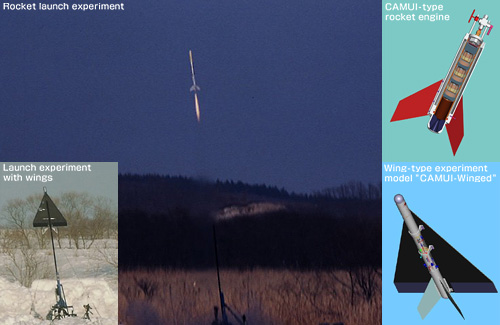TOP > Report & Column > The Forefront of Space Science > 2005 > Hybrid Rocket “CAMUI”
![]()

Introduction The main purpose of rockets launched from the ground is to put satellites into orbit around the earth. In addition, rockets are frequently used for academic purposes such as the aerological weather observation and microgravity experiments, by performing ballistic flight to 50 to 1,000km altitude. Rockets used for such purposes are called sounding rockets. In recent years, chemical-weather interaction is attracting wide attention because, for example, an atmospheric chemical model experiment proved that the progress of global warming exacerbates the descent of stratospheric ozone to the troposphere, which further accelerates global warming (Sudo K., Takahashi M., Akimoto H., Geophysical Research Letters, Vol. 30, pp. 24, 2003). Research on such phenomenon requires the collection of atmospheric constituents in the stratosphere and the identification of the composition of minor chemical constituents by analysis with high-performance instruments on the ground. Sounding rockets provide the sole means for such sample collection because neither aircraft nor balloon can reach the upper stratosphere at 50 to 60km altitude. Sounding rockets are also used as a means to produce a microgravity environment extending for several minutes. The environment is created by ballistic flights of small rockets at altitudes from 100 to 200km. The cost of experiments using rockets is generally in tens of million yen and, furthermore, experimental opportunities are rare. The reason for few opportunities in Japan is the small demand, and the small demand is due to the expensive rocket experiment cost. The potential demand, however, is not actually small. There are many metrological and microgravity researchers hoping to use rocket experiments if they were available at low cost. Their researches cover a wide range of fields including global warming, the generation and depletion of the ozone layer, combustion, crystal growth, and life science. These are the increasing potential demands if the rocket experiment cost were reduced. The reason for the expensive cost of rocket experiments is the high cost of small rockets. The small rockets used for experiments are all solid rockets that use explosives for their propellant. This is because the weak points with liquid rockets, such as their complex structure and heavy weight, become more prominent in smaller rockets. The solid rocket’s structure is simple: it is basically a cylinder full of explosives with a nozzle and stabilizing fin mounted on its body. Both material costs and manufacturing costs are inexpensive. Nonetheless, the price of a small rocket is expensive. This is because it uses explosives for propellant. The major cost of a solid rocket is absorbed by the management cost of the explosives. If we can develop a small rocket that does not use explosives for propellant, we can drastically reduce the cost of rocket experiments by repeated use of the rocket, and thus attract potential users. From this viewpoint, a group including the author is proceeding with research and development of a hybrid rocket. Our hybrid rocket uses a combination of liquid and solid for propellant. Generally, solid is used for fuel side. Since our rocket does not use explosives, a large reduction in manufacturing and operation costs becomes possible. In addition, since no liquid fuel is used, there is no need to handle dangerous materials. The idea of the hybrid rocket is old, dating back to the 1930s. But the crucial problem of solid fuel – slow combustion – has not been overcome, and no hybrid rocket has been used practically as a small rocket launcher. While velocity of 9.8m/s is lost per second to the earth’s gravity, the problem of slow combustion is decisive. CAMUI-type hybrid rocket To speed up the combustion of solid fuel that is essential for its practical use in a small launcher, we devised a new combustion method. We separated conventional cylinder-shape solid fuel with a central port into multiple cylinder blocks so that the fore-ends of all cylinder blocks burn concurrently. ”CAMUI” was named by abbreviating this new method “Cascaded Multistage Impinging-jet.” Fig. 1 shows the combustion-chamber concept for CAMUI. Liquid oxidizer injected into the combustion chamber collides with the fore-end of the first stage of fuel blocks to generate combustion gas. The gas flows downstream through two ports in the first block and, then, collides with the fore-end of the second block. This mechanism is designed to accelerate heat transfer to the solid fuel using the impinging jet. In the method CAMUI adopted, the thrust density (i.e., thrust per unit volume of the combustion chamber) can be increased without limit theoretically by segmenting the fuel block into a number of thin blocks. In practice, the mechanical strength of the blocks and pressure loss present an upper limit. In the author’s experience, it is possible to increase the thrust density to at least three times more than the conventional type. Thus, we were able to downsize and increase thrust to solid-rocket levels.
|
||||||||






